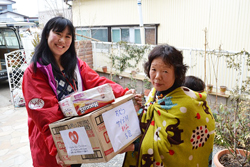The Association for Aid and Relief (AAR) Secretary-General, Yoshiteru Horie, wrote twice to thank JCIE for supporting their efforts. He said that he had just returned from a visit to hard-hit areas such as Soma, Sendai, and Rikuzentakata, noting that “the extent of destruction is so immense that I cannot find the words to adequately describe it.” He also mentioned, “We are most grateful to be selected as a recipient of the JCIE fund and will do our best to put the money to good use.”
The Association of Medical Doctors of Asia (AMDA) reported many cases of stress-related ailments, eye problems caused by powdered dust from the rubble, and problems related to the unbalanced diet of the evacuees. Norovirus (stomach virus) is still prevalent in Minamisanriku, although the preventive hygiene measures implemented by AMDA have helped to control the outbreak. In response to these trends, AMDA sent relief goods such as vitamin supplements, dust-proof goggles, and paper towels to both Iwate and Miyagi Prefectures. As of April 12, AMDA had 131 personnel working in the region: 48 doctors, 27 nurses, 3 midwives, 2 assistant nurses, 3 pharmacists, 2 psychotherapists, 43 coordinators (including interpreters), 2 careworkers, and 1 acupuncture therapist.
Peace Winds Japan (PWJ) has started a movie caravan to help break up the monotony at the evacuation centers. PWJ appealed to Studio Ghibli, one of Japan’s leading animation studios, which provided projectors, screens, and DVDs to entertain the children. As of April 9, the movies “My Neighbor Totoro” and “Kiki’s Delivery Service” had been shown in 5 locations in Kesennuma (Miyagi Prefecture). On the 8th, for example, a 100-inch screen was set up at the Kesennuma High School gymnasium, and the curtains were closed to create a movie theater. The previous night, a strong aftershock had knocked out the electricity again, so a generator was used to show the movie, much to the delight of children and adults alike. The caravan will be heading to Rikuzentakata, Minamisanriku, and Ofunato as well.
The Association for Aid and Relief (AAR) delivered supplies to a church preschool in Ishinomaki for about 30 infants that are enrolled there as well as for in-home evacuees nearby. They brought 20 cartons of diapers, 10 cartons of wipes, formula, toys, children’s clothing, milk, juice, pressure washers, rubber boots, etc. AAR staff spoke with one woman whose car and many household goods had been swept away by the tsunami. The gas was finally restored to her house on April 10, but her bathtub had been destroyed, so she had to go to a neighbor’s house to bathe. She noted that many people from the Oshika Peninsula, which was devastated by the tsunami, had come to Ishinomaki to stay with relatives, escaping with just the clothes on their backs. One month after the disaster struck, shops have begun to reopen in Ishinomaki, goods are being delivered to the evacuation centers, and food is coming into the town. However, without a car, she cannot go out to buy food, and even if she does get the ingredients, she still has no utensils to cook with.


